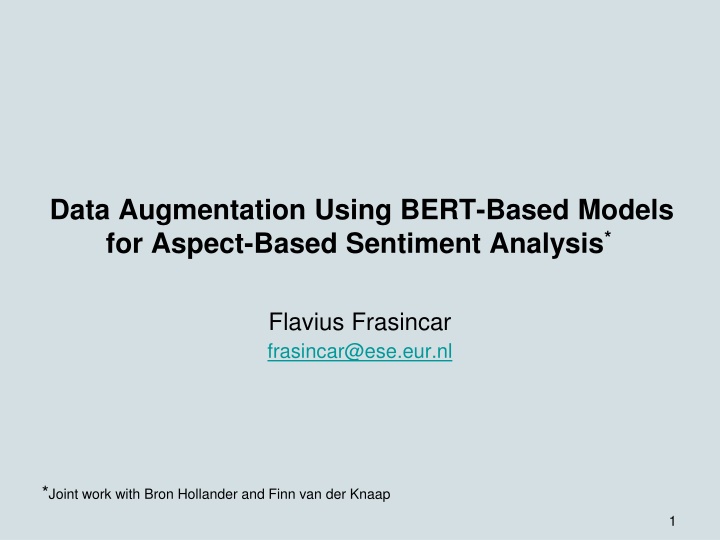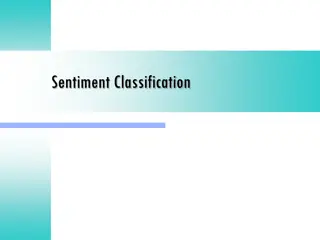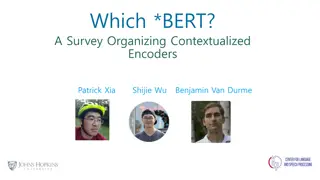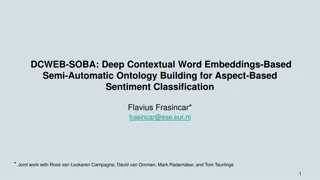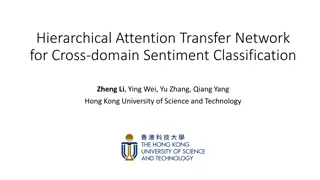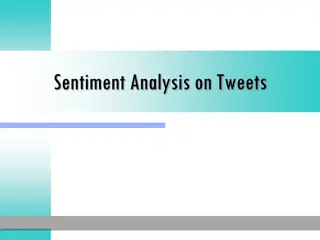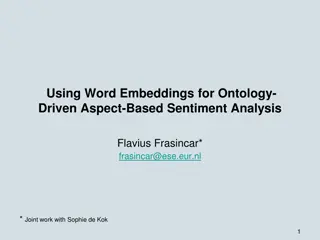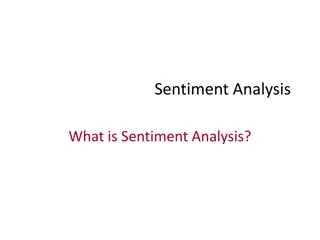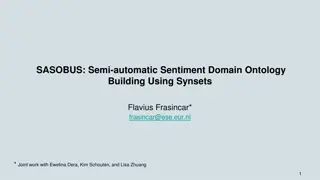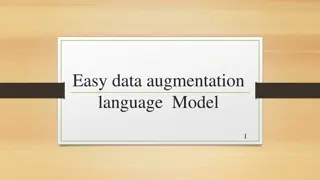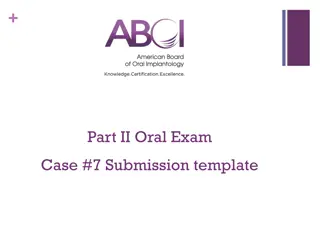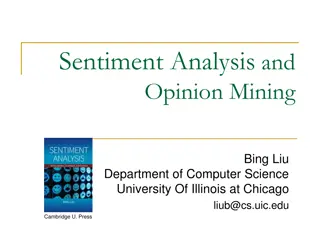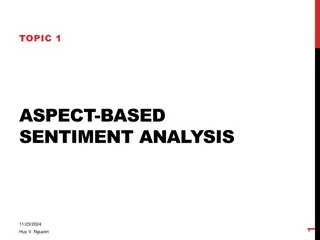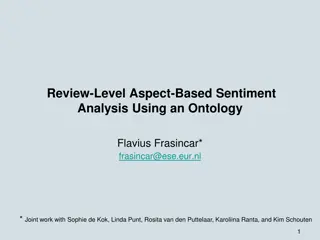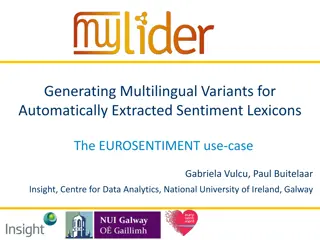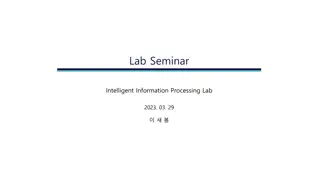Data Augmentation Using BERT-Based Models for Aspect-Based Sentiment Analysis
This research explores the use of BERT-based models for data augmentation in aspect-based sentiment analysis. Motivated by the growing importance of consumer reviews, the study focuses on sentiment mining at the aspect level, particularly in product reviews. The two-stage process of aspect detection and sentiment classification is examined, with a specific emphasis on the use of HAABSA++ for sentence-level analysis and overcoming data limitations through augmentation techniques.
Download Presentation

Please find below an Image/Link to download the presentation.
The content on the website is provided AS IS for your information and personal use only. It may not be sold, licensed, or shared on other websites without obtaining consent from the author.If you encounter any issues during the download, it is possible that the publisher has removed the file from their server.
You are allowed to download the files provided on this website for personal or commercial use, subject to the condition that they are used lawfully. All files are the property of their respective owners.
The content on the website is provided AS IS for your information and personal use only. It may not be sold, licensed, or shared on other websites without obtaining consent from the author.
E N D
Presentation Transcript
Data Augmentation Using BERT-Based Models for Aspect-Based Sentiment Analysis* Flavius Frasincar frasincar@ese.eur.nl *Joint work with Bron Hollander and Finn van der Knaap 1
Contents Motivation Related Work Data Methodology Evaluation Conclusion Future Work Further Information References 2
Motivation Growing number of reviews: In 2020: the number of reviews on Amazon around 250 million Growing importance of reviews: Consumers: 80% of the consumers read online reviews 75% of the consumers consider reviews important Companies: Improve products Marketing products Reading all reviews is time consuming, therefore the need for automation 3
Motivation Sentiment miningis defined as the automatic assessment of the sentiment expressed in text (in our case by consumers in product reviews) Several granularities of sentiment mining: Document-level Paragraph-level Sentence-level Aspect-level (product aspects are sometimes referred to as product features): Aspect-Based Sentiment Analysis (ABSA) firstly surveyed by Schouten and Frasincar (2016): Document-level Paragraph-level Sentence-level [our focus here] 4
Motivation ABSA has two stages: Aspect Detection (AD): finding aspects in product reviews recently surveyed by Trusca and Frasincar (2023) Explicit aspect detection: aspects appear literally in product reviews [our focus here] Implicit aspect detection: aspects do not appear literally in the product reviews Aspect-Based Sentiment Classification (ABSC): assigning the sentiment associated to explicit or implicit aspects recently surveyed by Brauwers and Frasincar (2023) [our focus here] Three approaches for ABSA: Knowledge Representation (KR) Machine Learning (ML) Hybrid: current state-of-the-art, e.g., A Hybrid Approach for Aspect-Based Sentiment Analysis++ (HAABSA++) proposed by Trusca et al. (2020) 5
Motivation HAABSA++ is a two-step approach for ABSA at sentence-level: 1. Ontology-based reasoning 2. Deep learning (backup solution): LCR-Rot-hop++ Problem: There is a little annotated data to train the deep learning solution Solution: Use data augmentation to enlarge the annotated data set 6
Related Work HAABSADA proposed by Liesting et al. (2021): Applied to HAABSA (precursor of HAABSA++) Used the data augmentations techniques: Easy Data Augmentation (EDA) Back-translation Mixup Proposed a new data augmentation technique: EDA-adjusted Best performance obtained with EDA-adjusted Data augmentation using Pre-trained Transformer Models (PTMs) by Kumar et al. (2020): Used for sentiment analysis Used PTMs: BERT, C-BERT, GPT-2, BART Our focus: data augmentation using BERT-based (encoder) models for HAABSA++ 7
Data SemEval: SemEval 2015, Task 12, Subtask 1, Slot 3 for restaurants reviews SemEval 2016, Task 5, Subtask 1, Slot 3 for restaurant reviews 3-point sentiment scale: positive, neutral, and negative Example: 8
Data SemEval Descriptive Statistics: Positive Neutral Negative Total Dataset Freq. % Freq. % Freq. % Freq. SemEval 2015 training data 962 75.3 36 2.8 280 21.9 1278 SemEval 2015 test data 353 59.1 37 6.2 207 34.7 597 SemEval 2016 training data 1319 70.2 72 3.8 489 26.0 1880 SemEval 2016 test data 483 74.3 32 4.9 135 20.8 650 Neutral is the minority class Positive is the majority class 20% of training data set aside for validation (hyperparameter tuning) 9
Methodology ABSC: LCR-Rot-hop++ LCR-Rot-hop++: BERT word embeddings Three Bi-LSTMs (left context, aspect target, right context) Two iterative steps using bilinear attention: Target2Context: uses the target representation (initially pooled) to obtain target-dependent left/right context representations (two vectors) Context2Target: uses the left/right context representations to obtain left/right context-dependent target representations (two vectors) Hierarchical attention (part of the previous two iterative steps): After Target2Context: apply attention to the obtained two vectors After Context2Target: apply attention to the obtained two vectors Repeat the two iterative steps a number of hops (e.g., 3) 10
Methodology 11
Methodology Data Augmentation: EDA-adjusted (benchmark) BERT C-BERT BERTprepend BERTexpand Three main steps: 1. Fine-tuning BERT models for Masked Language Modeling (MLM) on the training data 2. Apply the fine-tuned BERT models on the training data using MLM to generate new sentences (15% chance to replace a word by the word with the highest probability excluding the original word) 3. Train LCR-Rot-hop++ on the augmented data 12
EDA-Adjusted WSD: Lesk Simplified algorithm: uses the WordNet synset that has the largest overlap between its gloss and the sentence from which the word to be disambiguated originates Data augmentation operations: Synonym Replacement: replace a word with a synonym Random Insertion: insert the synonym of a sentence word in a random place in a sentence Target Swap: swap two aspect targets that belong to the same aspect category 13
BERT Sentiment label is not used 14
C-BERT Sentiment label is used as segment 15
BERTprepend/BERTexpand Sentiment label is used at the beginning of the sentence For BERTexpand the sentiment label is added to the model vocabulary 16
Evaluation SemEval 2015 (small dataset): EDA-adjusted has highest test accuracy (3.85 percentage points over HAABSA++) EDA-adjusted has three times more augmentations (three operations) C-BERT overfits and does not beat HAABSA++ 17
Evaluation SemEval 2016 (large dataset): EDA-adjusted is the worst model despite the three times more augmentation C-BERT overfits and does not beat HAABSA++ (again) BERTprepend and BERTexpand obtain the best results (1.85 percentage points over HAABSA++) 18
Evaluation EDA-adjusted: Lexicon-based method Works best for the small dataset C-BERT: Neglects the order between sentences Overfits BERTprepend and BERTexpand: Work best on the large dataset WordPiece tokenizer does not split the words positive and negative , so the two models give the same results 19
Conclusion Problem: There is a little annotated data to train the deep learning solution Solution: Use data augmentation to enlarge the annotated data set EDA-adjusted BERT-based (encoder): BERT C-BERT BERTprepend BERTexpand Small dataset: EDA-adjusted works best Large dataset: BERTprepend and BERTexpand work best 20
Future Work Experiment with other types of reviews: Laptops Hotels Books Consumer Electronics Selective Word Substitution (better sentence diversity by masking sentiment caring words) by Pantelidou et al. (2022) Adjectives, adverbs, and verbs SentiWordNet sentiment words Experiment with other PTMs: RoBERTa (encoder) GPT (decoder) BART (encoder-decoder) 21
Further Information Dataset and code publicly available at: https://github.com/BronHol/HAABSA_PLUS_PLUS_DA is written in Python Feel free to try it out and improve our research Questions about the code should be sent to Bron Hollander (511709bh@student.eur.nl) 22
References ABSA: Kim Schouten and Flavius Frasincar: Survey on Aspect-Level Sentiment Analysis. IEEE Transactions on Knowledge and Data Engineering 28(3):813-830 (2016) AD: Maria Mihaela Trusca and Flavius Frasincar: Survey on Aspect Detection for Aspect-Based Sentiment Analysis. Artificial Intelligence Review 56(5):3797-3846 (2023) ABSC: Gianni Brauwers and Flavius Frasincar: A Survey on Aspect- Based Sentiment Classification. ACM Computing Surveys 55(4):65:1-65:37 (2023) 23
References EDA-adjusted: Tomas Liesting, Flavius Frasincar, and Maria Mihaela Trusca: Data Augmentation in a Hybrid Approach for Aspect-Based Sentiment Analysis. 36th Symposium on Applied Computing (SAC 2021), pages 828-835, ACM (2021) DA with PTMs: Varun Kumar, Ashutosh Choudhary, Eunah Cho: Data Augmentation using Pre-trained Transformer Models, arXiv preprint arXiv:2003.02245 (2020) 24
References HAABSA++: Maria Mihaela Trusca, Daan Wassenberg, Flavius Frasincar, and Rommert Dekker: A Hybrid Approach for Aspect-Based Sentiment Analysis Using Deep Contextual Word Embeddings and Hierarchical Attention. 20th International Conference on Web Engineering (ICWE 2020). LNCS, Volume 12128, Springer, 365-380 (2020) DA with Selective Word Substitution: Kyriaki Pantelidou, Despoina Chatzakou, Theodora Tsikrika, Stefanos Vrochidis, and Ioannis Kompatsiaris: Selective Word Substitution for Contextualized Data Augmentation. 27th International Conference on Natural Language & Information Systems (NLDB 2022), LNCS, Volume 13286, Springer, 508-516 (2022) 25
Examples Original: My husband said he could ve eaten several more, the portion was fine for me he even exclaimed that the french fries were the best he has had. EDA-adjusted: My married manenunciatehe could ve feed several more, the portion was fine for me he even proclaim that the french christopher fry were the better he has had. BERT: My reliablesaid he could ve eaten several times, the portion was fine for me he even exclaimed that the french fries are his best he had had. 26
Examples C-BERT: My husband said he could ve eaten several more, the portion was fine for me he even exclaimed that the losing fries were the finest he has had. BERTprepend and BERTexpand: My husband said he could ve eaten several much, the portion was fine for me he even exclaimed that the losing fries were the finest he has had. 27
